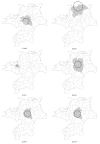Geographic prediction of tuberculosis clusters in Fukuoka, Japan, using the space-time scan statistic
- PMID: 17428326
- PMCID: PMC1853096
- DOI: 10.1186/1471-2334-7-26
Geographic prediction of tuberculosis clusters in Fukuoka, Japan, using the space-time scan statistic
Abstract
Background: Tuberculosis (TB) has reemerged as a global public health epidemic in recent years. Although evaluating local disease clusters leads to effective prevention and control of TB, there are few, if any, spatiotemporal comparisons for epidemic diseases.
Methods: TB cases among residents in Fukuoka Prefecture between 1999 and 2004 (n = 9,119) were geocoded at the census tract level (n = 109) based on residence at the time of diagnosis. The spatial and space-time scan statistics were then used to identify clusters of census tracts with elevated proportions of TB cases.
Results: In the purely spatial analyses, the most likely clusters were in the Chikuho coal mining area (in 1999, 2002, 2003, 2004), the Kita-Kyushu industrial area (in 2000), and the Fukuoka urban area (in 2001). In the space-time analysis, the most likely cluster was the Kita-Kyushu industrial area (in 2000). The north part of Fukuoka Prefecture was the most likely to have a cluster with a significantly high occurrence of TB.
Conclusion: The spatial and space-time scan statistics are effective ways of describing circular disease clusters. Since, in reality, infectious diseases might form other cluster types, the effectiveness of the method may be limited under actual practice. The sophistication of the analytical methodology, however, is a topic for future study.
Figures



References
MeSH terms
LinkOut - more resources
Full Text Sources

